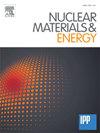Impurity study to assess N = 1D ICRF heating scenario in T-rich plasmas with D-beams during JET-ILW DT experimental campaigns
IF 2.7
2区 物理与天体物理
Q1 NUCLEAR SCIENCE & TECHNOLOGY
引用次数: 0
Abstract
A JET D-T scenario with optimised non-thermal fusion has been developed and successfully demonstrated during the second JET deuterium–tritium campaign (DTE2) at JET-ILW [1]. By using fundamental deuterium (D) minority ICRF heating scenario (N = 1 D) and pure D-NBI heating in T-rich plasmas, an energy world record for the most fusion energy produced in a single fusion shot has been achieved, by generating 69 MJ of heat from fusion reactions. During scenario optimisation, a systematic study of impurity behaviour has been performed. The impurities were analysed using various diagnostic techniques, e.g. VUV, VIS spectroscopy, and bolometry. The influence of different factors, including the plasma parameters and the heating methods has been investigated. The high-power T-rich hybrid pulses with different D gas puff rates in the main heating phase were compared to determine the influence of the D/T ratio on impurity behaviour. It was found that the intrinsic impurity content and the radiated power increase with the D/T ratio. Additionally, discharges in T-rich plasmas were compared with hybrid-like pulses with 50/50 D/T plasma mixtures and different ICRF heating schemes. It was found that T-rich plasmas, in which the highest fusion power was achieved are characterised by the lowest impurity content and highest ELM frequency (fELM ∼ 80–100 Hz), which increases with the fuelling rate. In some cases, the duration of the high-performance phase in T-rich plasmas was limited by impurity accumulation in the plasma core. Experimental and theoretical investigation showed that the high-Z impurity accumulation is related to the impurity transport inside the plasma and not related to the impurity source.
杂质研究,以评估 JET-ILW DT 实验活动期间富 T 等离子体中使用 D 射束的 N = 1D ICRF 加热情景
在 JET-ILW 的第二次 JET 氘氚活动(DTE2)期间,开发并成功演示了具有优化非热核聚变的 JET D-T 方案[1]。通过在富 T 等离子体中使用基本氘(D)少数 ICRF 加热方案(N = 1 D)和纯 D-NBI 加热,通过聚变反应产生了 69 兆焦耳的热量,创下了单次聚变射产生最多聚变能的世界纪录。在方案优化过程中,对杂质行为进行了系统研究。利用各种诊断技术,如紫外可见光、可见光光谱和螺栓测量法,对杂质进行了分析。研究了不同因素的影响,包括等离子体参数和加热方法。为了确定 D/T 比率对杂质行为的影响,对主加热阶段中不同 D 气体膨化率的高功率富 T 混合脉冲进行了比较。研究发现,本征杂质含量和辐射功率随 D/T 比率的增加而增加。此外,还将富含 T 的等离子体中的放电与 50/50 D/T 等离子体混合物和不同 ICRF 加热方案的类混合脉冲进行了比较。研究发现,富T等离子体的杂质含量最低,ELM频率最高(fELM ∼ 80-100 Hz),而且随着燃料率的增加而增加。在某些情况下,富 T 等离子体中高性能阶段的持续时间受到等离子体核心杂质积累的限制。实验和理论研究表明,高 Z 杂质累积与等离子体内部的杂质传输有关,而与杂质源无关。
本文章由计算机程序翻译,如有差异,请以英文原文为准。
求助全文
约1分钟内获得全文
求助全文
来源期刊

Nuclear Materials and Energy
Materials Science-Materials Science (miscellaneous)
CiteScore
3.70
自引率
15.40%
发文量
175
审稿时长
20 weeks
期刊介绍:
The open-access journal Nuclear Materials and Energy is devoted to the growing field of research for material application in the production of nuclear energy. Nuclear Materials and Energy publishes original research articles of up to 6 pages in length.
 求助内容:
求助内容: 应助结果提醒方式:
应助结果提醒方式:


